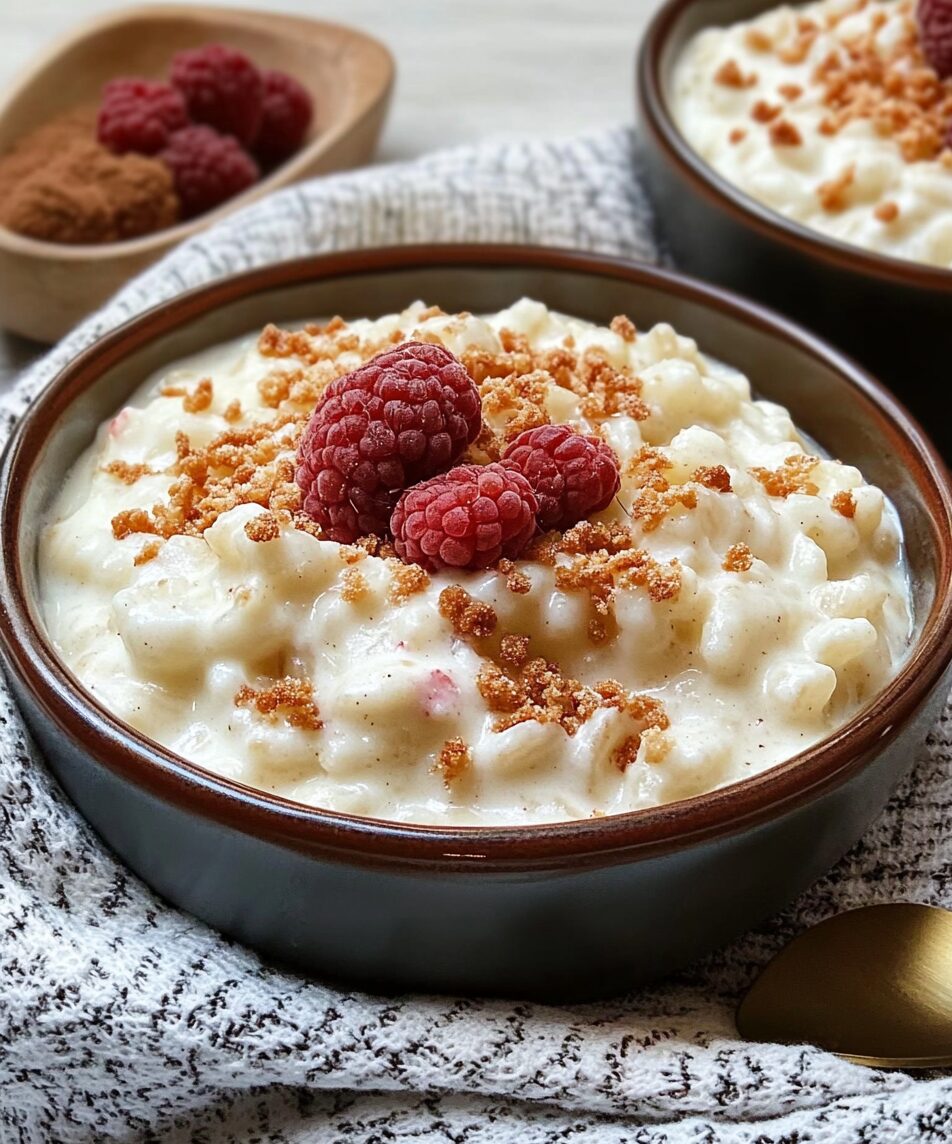This Creamy Vanilla Rice Pudding is a heartwarming dessert that’s perfect for both casual family meals and special occasions. The delicate texture of the rice combined with the rich flavor of vanilla creates a dessert that is both comforting and sophisticated. The addition of cinnamon adds a warm spice note, making each bite a delightful experience.
Whether you enjoy it warm or cold, this rice pudding is sure to become a family favorite. Serve it topped with a sprinkle of ground cinnamon or a handful of raisins for extra sweetness and texture. This recipe is a great way to use pantry staples to create a dessert that feels luxurious and indulgent.
Full Recipe:
Ingredients:
- 1 cup of uncooked white rice
- 2 cups of water
- 3 cups of whole milk
- 1/2 cup of granulated sugar
- 2 tablespoons of unsalted butter
- 1 teaspoon of vanilla extract
- 1/4 teaspoon of salt
- 1/4 teaspoon of ground cinnamon
- 1/4 teaspoon of nutmeg (optional)
- 1/4 cup of raisins (optional)
Directions:
- In a medium saucepan, bring the water to a boil. Add the rice, reduce the heat to low, cover, and let it simmer for 20 minutes until the rice is tender.
- Once the rice is cooked, add the milk, sugar, and salt to the saucepan. Stir well and cook over medium heat, stirring frequently, until the mixture becomes thick and creamy—about 15-20 minutes.
- Remove from heat and stir in the butter, vanilla extract, and ground cinnamon. If desired, fold in the nutmeg and raisins for added flavor.
- Transfer the rice pudding into serving bowls. Sprinkle with a little extra cinnamon on top for a lovely presentation.
- Serve warm or chilled, depending on your preference.
Prep Time: 5 minutes | Cooking Time: 40 minutes | Total Time: 45 minutes
Kcal: 230 kcal | Servings: 4 servings
History and Origins
Rice pudding has a rich history that dates back to ancient times. It’s believed to have originated in Asia, where rice was first cultivated. As it spread through Europe and the Americas, various cultures adapted the dish to their tastes, adding different flavors, spices, and ingredients. This creamy dessert became a beloved comfort food in many households, cherished for its simplicity and the nostalgic feelings it evokes.
Ingredients Breakdown
- Rice: Typically, short-grain rice is preferred for its ability to absorb liquid and create a creamier texture. Arborio rice, often used in risottos, is a great choice for its starch content.
- Milk: Whole milk is recommended for a rich, creamy texture. However, you can substitute with almond milk, coconut milk, or a combination of milk types for different flavors and dietary needs.
- Sugar: Granulated sugar is commonly used, but you can experiment with brown sugar or natural sweeteners like honey or maple syrup for a unique twist.
- Flavorings: Vanilla extract is the star here, providing a warm, aromatic flavor. Ground cinnamon and nutmeg are optional spices that enhance the pudding’s overall taste.
Cooking Tips
- Cooking the Rice: Rinse the rice before cooking to remove excess starch, which can make the pudding too gummy. Cooking it in water first helps achieve the right texture.
- Stir Frequently: When adding milk, make sure to stir the mixture regularly to prevent the rice from sticking to the bottom of the pot and to ensure even cooking.
- Texture Preference: If you prefer a thicker pudding, cook it a little longer after adding the milk. For a creamier consistency, you can add more milk to achieve your desired texture.
Serving Suggestions
- Toppings: Serve with a sprinkle of ground cinnamon, grated nutmeg, or a drizzle of honey. Fresh fruits like berries or banana slices also pair well.
- Chilled or Warm: Rice pudding can be enjoyed warm right off the stove or chilled in the refrigerator. It often thickens as it cools, so you may need to stir in a little milk if it becomes too thick.
- Storage: Store any leftovers in an airtight container in the refrigerator for up to 3 days. It can also be frozen, but the texture may change slightly upon thawing.
Variations
- Fruit Additions: Incorporate raisins, chopped apples, or dried cranberries for added sweetness and texture.
- Flavor Variations: Experiment with other extracts like almond or coconut, or even citrus zest for a refreshing twist.
Cultural Significance
Rice pudding holds a special place in many cultures around the world. In the United States, it’s often a nostalgic dish that many remember from childhood, frequently served in school cafeterias. In Europe, variations can be found, such as the British rice pudding, often baked with a layer of cream on top, or the Italian risolatte, which is usually flavored with lemon and sometimes served with a sprinkle of cinnamon. In Latin American countries, a version called arroz con leche is popular, often sweetened with condensed milk and flavored with cinnamon sticks and lime zest. Each culture brings its unique spin to this timeless dish, making it a versatile and beloved dessert.
Nutritional Information
Rice pudding can be a comforting and satisfying dessert, but it’s also essential to consider its nutritional profile. Here’s a breakdown based on one serving (about 1 cup):
- Calories: Approximately 230 kcal
- Carbohydrates: 36 g
- Protein: 6 g
- Fat: 6 g
- Fiber: 1 g
- Sugar: 10 g (can vary based on how much sugar you add)
- Calcium: About 150 mg (depends on the milk used)
- Iron: 1 mg
This dessert can be part of a balanced diet when enjoyed in moderation. For a healthier version, you might reduce the sugar, use low-fat milk, or add nuts and fruits for additional nutrients.
Storage and Reheating
- Refrigeration: Store the rice pudding in an airtight container in the refrigerator. It can last up to 3-4 days.
- Freezing: While rice pudding can be frozen, be aware that the texture may change upon thawing, becoming grainy. If you plan to freeze it, consider undercooking it slightly before freezing, then reheat and adjust the consistency with added milk.
- Reheating: Gently reheat on the stovetop over low heat, stirring frequently, or in the microwave in short intervals. Add a splash of milk to restore creaminess.
Pairing Suggestions
Rice pudding can be a delightful end to a meal, but it can also be paired with other dishes. Here are some ideas:
- With Fresh Fruits: Serve with berries, mango, or banana slices for a refreshing contrast.
- With Nuts: Top with chopped nuts like almonds, pistachios, or walnuts for added crunch and flavor.
- With Cream: A dollop of whipped cream or crème fraîche can elevate the dish, making it more indulgent.
- With Sauces: Drizzle caramel or chocolate sauce over the top for a decadent twist.
Variations and Creative Twists
- Chocolate Rice Pudding: Stir in cocoa powder or melted chocolate while cooking for a rich chocolate flavor.
- Coconut Rice Pudding: Substitute part or all of the milk with coconut milk for a tropical flair. Adding shredded coconut will enhance the flavor.
- Spiced Versions: Experiment with spices like cardamom or ginger for an aromatic profile.
- Savory Rice Pudding: For a unique twist, try a savory version by reducing sugar and adding cheese or herbs, making it a side dish instead of a dessert.
Conclusion
Creamy vanilla rice pudding is more than just a dessert; it’s a canvas for creativity. Its base recipe is simple, allowing for a multitude of flavors and presentations. Whether you prefer it traditional or with a modern twist, rice pudding remains a cherished dish that can bring comfort and joy to any table. Experiment with flavors and toppings to find your perfect version of this timeless classic, and don’t hesitate to make it your own!

